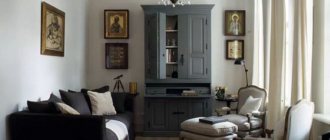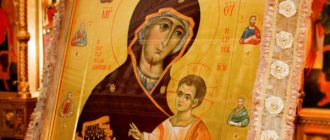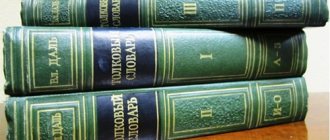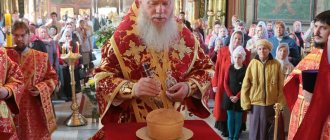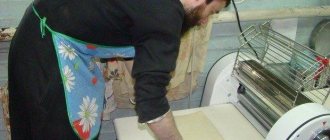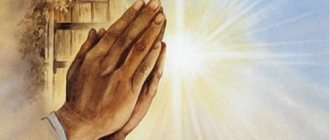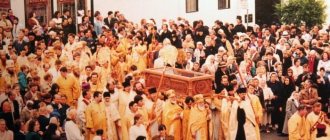Profession – icon painter: how icons are born
“I asked and it was given”
Creating an icon is a unique process.
This is not just creativity. The icon painter is a mediator between Heaven and all of us on earth. They say that monks in monasteries pray with special zeal for icon painters, since these are the people through whom we communicate with God. If the master, while working, was pure in soul and thoughts, and distanced himself from worldly things, it means that his icon will come out with his soul. But mastering the skill of a restorer, especially an icon painter, until relatively recently was extremely difficult - there were no textbooks or any other published aids.
Working on an icon in a creative workshop.
Head of the creative workshop “Iconography” Vladimir Snytin:
Vladimir Snytin
“I didn’t think that I would ever become a restorer.” When I entered the art school in Moscow, I attended preparatory courses. We had such a teacher, Struchkov, he told me: “I see you only draw temples.” And he suggested: “Think about it, maybe you shouldn’t be a painter, but a restorer? This is closer to you."
Although I gained no less knowledge than in college while studying in Tula in the studio of Konstantin Mikhailovich Kortukov,” continues Vladimir Snytin. — She worked at the Hammer and Sickle House of Culture. Konstantin Mikhailovich is a legendary person for Tula, a childhood friend of Porfiry Nikitich Krylov. I learned a lot from him.
I was especially lucky to have received training from leading experts in the field of restoration. At the Russian Academy of Painting, Sculpture and Architecture, whose rector was Ilya Glazunov, the oldest restorer of Russia, Filatov, taught restoration, and the secrets of icon painting were taught by Sokolov himself, who had the opportunity to restore the icons of Rublev and Dionysius.
Yuri Barabanov has his own story of how he ended up in this profession:
Yuri Barabanov
— I was always involved in outdoor advertising, but in my heart I wanted to change something. And then a series of troubles began with work, my wife advised me to go to church. I went to the Church of the Annunciation of the Blessed Virgin Mary and made a request to St. Nicholas the Wonderworker. The next day, friends come and say that hands are needed to gild the dome in the same Church of the Annunciation. I didn't hesitate for a second. And there I already met my comrades. Like this: I asked, and it was given.
Anatoly Alekseev
— Vladimir later taught us all how to do gilding. This is a special art. My story is also interesting. After Polytechnic he was assigned to KBP as a design engineer. I worked for three years until I became eager to move to the art department under any conditions. But I didn’t tell anyone about this. Why should I become an artist? While still at the Polytechnic, I simultaneously graduated from the People’s University of Arts by correspondence and studied in the Tula art studios.
“One day I decided to go to the authorities with a request for a transfer, and then a miracle happened - I was invited to work there as an artist. And even with an increased salary,” recalls Anatoly. — How and why this happened is still a mystery to me. Subsequently, a very young Volodya Snytin came to work for us. There, at KBP, we met him.
In 1991, he quit his job, began painting, and participated in a serious, large exhibition for the first time. He earned extra money by painting samovars, nesting dolls and decorating shop windows. Everything was missing, including restoration. It didn't bring in a lot of money, but it was quick. At the same time, I studied the basics of craftsmanship. They introduced me then to the greatest specialist in this field, Igor Borisovich Shchelokov, who back in the 70s worked in all the old Tula churches. By the way, he also painted the oldest temple in Tula - the Annunciation. It was he who taught me the technique of icon painting.
They were all united in 2004 by one large work - the Church of St. Nicholas on Rzhavets, which stands in the courtyard of a round house on the corner of Krasnoarmeisky and Sovetskaya. A family of icon painters from Moscow was invited to paint the temple. They had already started work, but they didn’t like something, and they decided to return to Moscow. Then, at the request of the rector of the temple, Vladimir Snytin, Anatoly Alekseev and Yuri Barabanov began work. This was their first joint temple painting project.
Everyone has their own history of the world
In Tula at all times there was a strong local school of icon painters. There were even entire family dynasties. One of the most famous masters is Grigory Belousov, whose works can still be found in some old churches. He also painted several icons in the Kremlin Assumption Cathedral. This collection is now stored in the funds of the regional art museum. In the church inventory of the All Saints Church, it is written about Belousov’s icons: “The freshness of the colors, the care, even some artistry in the decoration of the figures, especially faces, and other advantages of icon painting put Belousov above ordinary icon painters.”
Tula masters not only painted icons, but also made magnificent frames for them.
Restorers often come across perfectly preserved unique frames, the identity of which can be judged by the presence of the coat of arms of Tula. We were able to create not only guns and samovars.
Yuri Barabanov: “Gilding of churches is a jeweler’s work.”
Modern masters continue the traditions that were laid down long before them. Although, of course, the new generation was brought up in slightly different traditions.
“We didn’t have the law of God at school, but in many families there were bearers of the faith - our grandparents,” says Vladimir Snytin. — Of course, you need to know the Holy Scriptures. And we certainly begin every work with prayer. But if you don't love what you do, you won't succeed.
Why do all the icons look roughly similar, but at the same time different? There is also a theory for this - each creator has his own perception of the world.
“Pikul has such an episode in his novel about Bismarck,” says Anatoly Alekseev. — A certain historian wrote the history of the world. But it turned out that a crime was committed in his yard, witnessed by three people - a groom, a cook and a coachman. They begin to question them, and each has their own version, unlike the others. And then the scientist thought: after all, they were all witnesses to the same event, but everyone saw it differently. And I started writing the history of the world! So our perception of the icon cannot be the same.
Basically, the icon painter is squeezed within the framework of the canon. The plot, location, who is dressed, how and what, the description of the saint are laid down in the canon, from which it is not customary to deviate. But within this plot, the master can make his own variations of color, coloring, and change movements. In the icon, the artist conveys his feelings, puts a sense of the surrounding world. Therefore, icons belonging to different historical eras are noticeably different from each other.
A correct icon is one where a person recognizes God in the painted image. It helps a person to pray, to convey his thoughts to the One who will definitely hear.
Each person has his own icon that awakens his feelings; even a simple calendar can touch him. After all, the human soul is a mystery to ourselves. Who actually paints these icons - whether the artist himself or the one who is moving his brush at that moment - no one can answer for sure. That's why the master never signs his work.
Photo from the archive of the publication’s heroes.
Bring joy to people
Since 2004, the artists of the creative workshop “Iconography” have completed a lot of what they consider important and iconic. And in general, each work is unique in its own way. They made the iconostasis of the Cathedral of the Assumption - not the Kremlin, but the former monastery, on Sovetskaya Street. By the way, its second floor was once painted by students of Viktor Vasnetsov.
They painted icons for the Church of the Nativity of the Virgin Mary in the village of Monastyrshchino. This matter is especially complex and responsible - after all, the Kulikovo Field.
“One of the most interesting works is the nineteenth-century Znamensky Church in the Kurkinsky district,” says Anatoly Alekseev. — We once went to this collective farm from the KBP (in Soviet times there was a practice of patronage assistance to collective and state farms from industrial enterprises - equipment, labor. - Author's note), I remember everything from that time. Nearby is a village that has been renamed several times throughout its history. First Znamenka, then Myshenka, now Znamensky. And Boris Gryzlov began to restore the parish. His grandfather once served in this temple, so in memory of him he decided to return the church to the people.
The places around are the most beautiful and legendary. Kulikovo Field is just a stone's throw from here. The Nepryadva River flows where, according to legend, the saber of Field Marshal Suvorov was once drowned. The granddaughter of the last Georgian king, George XIII, Elizaveta Bashmakova (Gruzinskaya), is buried at the temple. The story of its appearance in these places deserves a separate book.
Once upon a time in her homeland, her grandmother, Mariam Georgievna Tsitsishvili, a Georgian queen, rushed with a dagger at a Russian officer, and the whole family was exiled to Moscow for this offense. There, Elizabeth subsequently met the impoverished nobleman Arkady Bashmakov, the great-grandson of the Russian commander A.V. Suvorov, who took her to Znamenka. The family tree of George XIII indicates that the place of her burial is unknown, but in fact it is very well known - this is indicated by the gravestone near the walls of the temple.
Anatoly Alekseev painting the walls of the temple.
The work lasted about five years - literally everything was done from scratch. First they plastered the walls, then they started painting. But the temple turned out to be a joy for the people.
This, probably, is the main philosophy of the icon painter’s profession - to bring people joy and peace with their work.
I bought fish at the market and told my parents that I had caught it.
And so I got into the habit of leaving class early every day. I went to the temple and spent the whole day there. Got to know everyone. I loved listening to stories. And I didn't need anything else. I stood in the church all day long, looking at the icons and waiting for someone who came to ask me something, and I answered. He waited, inhaled the smell of incense, greedily caught, among other smells, the smell of the board on which icons were written... There were interesting people there. We were all different, of course. They came to the temple - talked, giggled, joked. But the church beckoned us. Despite our jokes. I was very unobtrusively taught to make the sign of the cross. I felt at home there. If you wanted it, you ate it; the pies were very tasty; if you wanted it, you rested. There I started drawing. In the kitchen, on some doors from old furniture. I was drawn there. It was a completely different world, everything was different. In the yard it’s one thing, the shantrapa is being collected, but there it’s completely different. And finally, I decided to be baptized. I was in 8th grade then. And so, secretly from my parents, I went to be baptized. I went to the village. He told his parents that he was going fishing. I remember the choir sang beautifully. I never saw my godmother again. It was a random person. I came home, bought fish at the market, and told my parents that I had caught it. I remember how, with tears, I proved that I had caught her. My parents didn’t believe me, but I proved it. That’s what it was like – such romance. And off we go. Handicrafts began to haunt me. I walked around the houses, looking into the neighbors’ windows to see what icons were there, if there were any at all.
In Russian iconography, no one influenced me - time, life, work influenced me
Team exhibition in 1992. I considered myself a mature icon painter, but now I understand that at that time I was just searching for myself - I painted in the Russian style, then imitated the Byzantine one. I was tossed from side to side, although I loved the Stroganov school. Solvychegodsk? Yes, Solvychegodsk, Veliky Ustyug. Not everyone can understand such icons, and making them is extremely difficult. It is easier to write imitating Byzantium. Who influenced you and became your teacher? In Russian iconography, no one influenced me - time, life, work influenced me. And the main thing is love for this business. The first album is Popov, Novgorod painting. And Fedor Zubov. I fell in love with him. I remember what paper smells like. Even now, sometimes I open this album and remember that time. I liked all the styles. Everything that is done professionally, with love, with trepidation. Yes, there was such a manner at such a time, but it was done with love. That’s how artists were raised back then, that’s how morals were. Of course, Byzantine icons captivated me. I remember how impressed I was by an album with frescoes from the Chora Monastery in Istanbul. I dreamed of going there. And then one day I found myself in Istanbul with a friend and the first thing I did was invite him to go see this wonderful monastery. He firmly assured me that Hora was in India. He didn’t want to go there so much, he didn’t need to go there so much that I couldn’t convince him, and we went to the shops.
It was this Byzantium that impressed me, not the Comnenian period, as Archimandrite Zinon liked to write. His works seemed schematic and iconic to me, but the paintings and frescoes of Chora seemed vivid to me. This is a revelation. This is what you need to see and be able to do. You can't write this off. I was very prolific in my youth. I could paint an icon in two days. I put down the board, took a pencil and went. He sat down and completely drowned. Is it possible to describe the style of Alexander Rudoy in words? I imperceptibly introduce something into iconography. I don’t have any special “tricks” - a hand like this, a tilt of my head like this... I make subtle strokes that over time, over the years, may change something in the iconography. How consistently the icon of Rublev was quietly and gently replaced by the icon of Dionysius. The letter becomes more concise, flat, with a subtle pattern - everything is clearly in its place. When I watch my colleagues imitate the Comnenian period, I see them scribbling. For example, I know that soot must show through from under the paint so that there is optical mixing of color. If we begin to outline a design with black paint and paint over it with ocher, then the black color shines through the ocher. The result is a greenish color. This can all happen – if done subtly. And there is garbage. One line is like this, the other is that. A person does not quite understand what he wants and does not know how to do it.
I always liked to think through my drawings to the smallest detail. How this finger goes, it will be this way or that. And all the searching in the process is unnecessary. The most important thing is a clear understanding and knowledge of the drawing. And see it immediately in color. You can make a gorgeous drawing, but when you write in color, do color loads, everything will change. You need a tough backbone. As one artist said, a drawing is 99 percent drawing and one percent color. Do you have any students? Do you want to create a school? No. There are only people who imitate something. Previously, at the very beginning, I wanted this - apparently out of pride. And in the process, I realized that this was unnecessary for me: I wouldn’t have time for anything either here or there. I don’t want to drag anyone down; I have to pull myself. I have a son, and my wife asks me to teach him to draw. Of course, I can tell and show him a lot. But I will do this a little bit at a time. You shouldn’t constantly engage with him, you should pick him up, and only on the condition that he himself wants it.
Day, two, three - I may not leave the room until I paint the icon. In one fell swoop, in one breath
What is the icon painter’s daily schedule? Let's take a better day. I dropped the child off at school. I stopped by home, drank tea - it was already 11 o’clock, by the time I got ready it was already 12. I also need to pick up something along the way, drop it off somewhere. I'm going to the workshop. I can't draw at home. There is no such opportunity - everything is distracting, it is impossible to tune in. They won't let me draw there. I’m going to my room (parental apartment) 3 by 3, it’s where I did a countless amount of work. Literally countless. I arrive tired, as if after work. Although I came to work. I still have to get involved in work, walk around, get fired up. I understand that I only have a couple of hours, and then I have to go pick up the child and do some shopping. And I don’t want to go anywhere. I just got ready... This is how we work. Evening – I looked something up on the Internet – it’s already one in the morning. It's time to sleep. Tomorrow I have to get up at seven for the child to go to school. When I lived on my own without a family, there was a connection between the days. I could do nothing, but one day smoothly turned into another. It’s a good morning – the sun is shining, there’s a kindergarten below the house. You hear children screaming, different sounds - I start getting ready for work, getting ready. So I start working and off I go. Day, two, three - I may not leave the room until I paint the icon. In one fell swoop, in one breath – once and done.
Need to burn. If I'm on fire, nothing can stop me. Of course, burning is a passion. Everything I do is passion. I had such a passion - to restore icons, bring them back to life and sell them. I could put off current work if I was passionate until I satisfied my interest, my passion - I calmed down. But passions go away. One elder told me, when I was still thinking about joining a monastery, that I wouldn’t succeed - I needed to have a fiery zeal for monasticism. But I don’t have it. And I understand him, I have such a fiery jealousy for the icon. I am so passionate about the icon that I didn’t even have time to organize exhibitions, write books, or do “PR.” And this is also wrong. One of my friends said: excessive modesty is the path to oblivion. I listened and decided to find out what they were writing about me on the Internet. I looked - there was little information and the wrong one. They don't know me, they don't feel me. For example, they say that I use synthetic paints. Yes, I do not use synthetic paints on all icons. Here, I registered on Facebook. I made a page and exhibited my work there.
Maybe you had a favorite icon? Icons are like children. I cannot protect some at the expense of others. But perhaps what I love to write most of all is St. Nicholas the Wonderworker. When I sit down to write, the icon is already completely born in my head. The whole drawing, color scheme, design. I'm getting ready. Click. And I understand that it will be this kind of icon, this size, this scale... I won’t make it very white, I will make it quiet, the emphasis will be on only one drawing... I know everything down to such details. Who is your heavenly patron? Alexander Nevskiy. But I love Alexander Svirsky more. One man left for America and gave the icon to St. Alexander Svirsky - palekh, probably made in a mannered, beautiful, tactful manner. The reverend looked so beautiful... But I sold it, couldn’t resist, and bought pants. What else fascinates you? I like the best of everything. The fantastic mosaic in Sofia on the second floor is a magnificent, accomplished painting and a wonderful craft. Murals of the Monastery in Chora. I know that we need to focus on the best, look at it, absorb it. At least something will remain, but the best.
